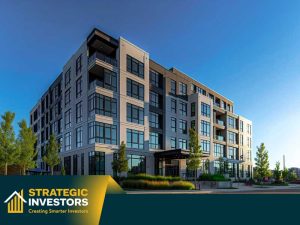
Is investment in apartment properties a savvy financial strategy? In this straight to the point guide, we’ll explore the critical factors that make apartments a popular choice for investors – affordability, consistent rental income, and potential for appreciation.
However, success hinges on a clear understanding of market trends, financing options, and realistic expectations of returns.
We’ve got the insights to help you decide if apartments should be part of your investment portfolio.
Key Takeaways
- Apartment properties offer a diverse investment opportunity, with lower entry costs and the potential for consistent rental income from a varied tenant pool. However, they may experience slower capital growth and present challenges like limited control over property decisions due to body corporate regulations.
- Financing an apartment investment requires careful consideration of available options, such as conventional bank loans, private money loans, or hard money loans, each with its own terms and impact on overall returns. Investors should also consider the implications of down payments and lenders’ mortgage insurance.
- Investors must conduct extensive market research, evaluate property management choices, and establish a long-term investment strategy to ensure success in apartment investing, accounting for factors like location benefits, competition, oversupply, and maintenance responsibilities.
Understanding Apartment Investments
 When you think about property investments, you might first picture single-family homes or commercial buildings. But there’s more to the property market than meets the eye. Apartment investments, including investment property options, are a vital asset class, offering a variety of investment grade properties for you to consider. From single units within larger apartment buildings to entire complexes, the scope of apartment investments is vast and full of potential.
When you think about property investments, you might first picture single-family homes or commercial buildings. But there’s more to the property market than meets the eye. Apartment investments, including investment property options, are a vital asset class, offering a variety of investment grade properties for you to consider. From single units within larger apartment buildings to entire complexes, the scope of apartment investments is vast and full of potential.
Securing an apartment is not merely about possessing a unit within a towering structure. It demands a thorough grasp of the financial avenues available to you, ranging from standard bank loans to private financings and even state-supported loans. Each financing option comes with its terms and implications, which could impact your rental income and overall returns. For instance, the interest rate on your loan could significantly influence your rental yield. A high rental yield equates to a good investment, but only when other factors such as location, property condition, and market trends are also favorable.
Types of Apartment Properties
Among the various types of investment-grade properties, apartments offer a unique range of investment opportunities. You could invest in a single unit within a larger apartment building, giving you a slice of the property market without the hefty price tag of a standalone house. Alternatively, you could take it a step further and invest in an entire apartment complex, consisting of multiple units. This not only diversifies your investment portfolio but also provides you with a consistent stream of rental income.
Nonetheless, the task of investing in an apartment complex isn’t free from hurdles. As the proprietor, the duty of upkeep for the whole complex falls upon you, demanding substantial time and resources. In contrast, investing in a single unit within a building shifts some of the maintenance responsibilities to the body corporate, letting you focus on maximizing your returns.
Financing Options for Apartment Investments
Financing an apartment investment can take multiple forms, and the best option for you primarily depends on your financial situation and investment goals. Some options to consider include:
- Conventional bank loan: This is a popular choice for many property investors due to its relatively low interest rates and predictable repayment structure.
- Private money loans: These loans are provided by individuals or private companies and may be more flexible in terms of lending criteria, but they usually come with higher interest rates.
- Hard money loans: Similar to private money loans, hard money loans are typically provided by private lenders and have higher interest rates.
Consider your options carefully and choose the financing option that aligns with your investment goals and financial situation.
When opting for a financial route, you should take into account the prerequisites for the down payment. Many financing options require a down payment of 10% to 30% of the property’s value. However, if you can afford to make a down payment of at least 20%, you can avoid the additional cost of lenders’ mortgage insurance, thereby reducing your overall financing costs.
Potential Returns from Apartment Investments
The potential returns from apartment investments stem from two primary sources: rental income and property value appreciation. In metropolitan areas, investors can expect gross rental yields typically ranging from 3% to 5%. Bear in mind, though, that apartments might provide lower capital returns in comparison to houses, as they do not incorporate the escalating value of land.
Another significant consideration is the property’s location. Proximity to amenities, employment opportunities, and transport links can significantly influence the property’s value and, consequently, its potential returns. However, not all apartments experience the same level of appreciation. Factors such as competition and oversupply can affect the property’s value and, in turn, your investment returns.
The Advantages of Investing in Apartments
 Investing in apartments offers several advantages that make it an attractive option for both novice and experienced investors. One notable advantage is affordability. Compared to houses and other real estate investments, apartments generally have lower entry costs. This makes them an appealing choice for first-time investors or those looking to diversify their investment portfolio without a substantial upfront financial commitment.
Investing in apartments offers several advantages that make it an attractive option for both novice and experienced investors. One notable advantage is affordability. Compared to houses and other real estate investments, apartments generally have lower entry costs. This makes them an appealing choice for first-time investors or those looking to diversify their investment portfolio without a substantial upfront financial commitment.
Another advantage of investing in apartments is the diverse tenant pool. From young professionals to small families, apartments attract a wide range of tenants, offering a more consistent rental demand and income. Furthermore, apartments often boast prime locations, providing easy access to amenities, transportation, and employment opportunities. These location benefits increase the appeal of the property to potential tenants and can contribute to higher rental yields.
Affordability and Lower Entry Costs
One of the most compelling advantages of investing in apartments is their affordability and lower entry costs. Compared to single-family homes and commercial properties, apartments generally have lower purchase prices, providing an affordable entry point for first-time investors. This affordability extends beyond the initial purchase price. For instance, the ongoing costs associated with owning an apartment, such as body corporate fees and maintenance costs, are typically lower than those of standalone houses.
Reduced entry costs make apartment investments particularly attractive to novice investors. These investors can leverage the lower costs to gain access to the property market without the hefty financial commitment often required for other types of real estate investments. Furthermore, the lower entry costs offer a prompt and economical method to diversify an investment portfolio, spreading the risk and potentially improving overall returns.
Diverse Tenant Pool
 Another significant advantage of investing in apartments is the access to a diverse tenant pool. From young professionals and students to small families, apartments appeal to a wide demographic. This diversity can lead to a more consistent rental demand, leading to higher occupancy rates and, consequently, a more dependable rental income.
Another significant advantage of investing in apartments is the access to a diverse tenant pool. From young professionals and students to small families, apartments appeal to a wide demographic. This diversity can lead to a more consistent rental demand, leading to higher occupancy rates and, consequently, a more dependable rental income.
A diverse tenant pool also provides a level of security for investors. If one tenant moves out, the wide appeal of apartments means you’re likely to find a replacement tenant quickly, reducing the risk of prolonged vacancies. Furthermore, if you own an apartment complex with multiple units, you won’t be relying on a single tenant for your rental income, spreading the risk and providing a more consistent cash flow.
Location Benefits
Location is a key factor in any real estate investment, and apartments often have an advantage in this regard. Apartments are typically built in:
- urban or suburban areas
- close to city centers
- public transportation
- schools
- various amenities like shopping centers and restaurants
These factors make high rise apartment buildings, with multiple apartments, appealing to a wide range of potential tenants, increasing demand and rental rates.
However, location benefits can also come with higher body corporate fees for maintaining common areas and amenities. Therefore, it’s important for investors to factor these costs into their budget and investment strategy. Despite these costs, the location benefits of apartments often outweigh the drawbacks, contributing to higher rental yields and capital growth over time.
The Disadvantages of Investing in Apartments
 While investing in apartments has many advantages, it’s not without its challenges. One of the main disadvantages is the limited control investors may have over their property. Unlike standalone houses, apartment investors must often abide by body corporate or strata rules, restricting their freedom to make certain decisions about the property.
While investing in apartments has many advantages, it’s not without its challenges. One of the main disadvantages is the limited control investors may have over their property. Unlike standalone houses, apartment investors must often abide by body corporate or strata rules, restricting their freedom to make certain decisions about the property.
Another disadvantage is the slower capital growth. While apartments can offer high rental yields, they generally experience slower capital growth compared to houses. This is largely because apartments lack the land value appreciation that comes with standalone houses.
Lastly, competition and oversupply in the apartment market can also pose challenges, leading to lower rental yields and property value appreciation.
Limited Control Over Property
One of the key challenges of apartment investing is the limited control over property decisions. Investors in a block of apartments typically form part of a body corporate or owners corporation, which is responsible for making decisions about common areas and the exterior of the building. While you retain exclusive rights to your individual apartment, any decisions concerning communal areas and external alterations often require consensus or adherence to strata regulations.
While this arrangement can reduce the burden of property management, it can also restrict your freedom as an investor. For example, you may face limitations on renovations, or you may need to comply with certain rules about renting out your property. However, by actively engaging in the body corporate and understanding the governing regulations, you can exercise a degree of influence over the property’s management.
Slower Capital Growth
Investing in apartments may come with the drawback of slower capital growth when compared to houses. This difference in growth potential should be carefully considered when making investment decisions. While apartments can offer high rental yields, they generally lack the land value appreciation that comes with standalone properties. This is because when you invest in an apartment, you’re essentially buying a share of a building, not the land it stands on.
However, the capital growth of apartments is not solely determined by land value. Other factors, such as location, property condition, and supply and demand dynamics, can also significantly influence an apartment’s capital growth. Therefore, while apartments may experience slower capital growth compared to houses, they can still be a viable investment option for those seeking consistent rental income.
Competition and Oversupply
Competition and oversupply are two significant challenges in the apartment market. When there is a high supply of apartments, competition among landlords can drive down rental prices, leading to lower rental yields. Furthermore, an oversupply of apartments on the market can also negatively impact property value appreciation.
However, these risks can be mitigated with thorough market research and strategic planning. By understanding the market dynamics and keeping a close eye on supply and demand trends, investors can make informed decisions about when and where to invest in apartments. Additionally, diversifying your investment portfolio across different property types can also help mitigate the risks associated with competition and oversupply.
Comparing Apartment Investments to Alternative Property Types
 Investing in apartments isn’t the only route to success in the real estate industry. Other property types, such as houses and townhouses, also offer unique advantages and can complement or even form the backbone of a balanced investment portfolio. By comparing apartments with these alternative property types, you can gain a more comprehensive understanding of the property market and make more informed investment decisions.
Investing in apartments isn’t the only route to success in the real estate industry. Other property types, such as houses and townhouses, also offer unique advantages and can complement or even form the backbone of a balanced investment portfolio. By comparing apartments with these alternative property types, you can gain a more comprehensive understanding of the property market and make more informed investment decisions.
Each property type offers a unique balance of capital growth and rental yield. For instance:
- Houses typically offer higher capital growth potential
- Apartments may offer higher rental yields
- Townhouses can provide a balance between the two, offering an affordable entry point for first-time investors
Understanding these differences can help you align your investment choices with your financial goals and risk tolerance.
Houses as an Investment
Investing in houses can provide several advantages over apartments. One of the main benefits is the potential for higher capital growth. Houses, particularly those with a large land component, often appreciate in value at a faster rate than apartments. This is largely due to the fact that land appreciates in value over time, while buildings, including apartment buildings, depreciate.
However, investing in houses also comes with higher initial costs and greater maintenance responsibilities. Houses typically have higher purchase prices than apartments, and as the sole owner of the property, you’ll be responsible for all maintenance and repair costs. Despite these drawbacks, houses can still be a good investment choice, particularly for investors seeking long-term capital growth.
Townhouses as an Investment
Townhouses can offer a middle ground between houses and high rise buildings. Like apartments, townhouses are often part of a complex with shared amenities and common areas, but they typically offer more space and a larger land component than apartments. This can translate to higher capital growth compared to apartments, albeit typically lower than that of standalone houses.
In terms of rental yield, townhouses often perform similarly to apartments. However, they may attract a different tenant demographic, potentially leading to higher rental rates. For investors looking to diversify their portfolio, townhouses can be an attractive option that combines the benefits of both apartments and houses.
Tips for Successful Apartment Investing
 Investing in apartments can be a rewarding venture, but it requires careful planning and strategic decision-making. To maximize your returns and minimize risks, it’s important to conduct thorough research, consider your property management options, and develop a long-term investment strategy. By taking these steps, you can navigate the challenges of the apartment market and set yourself up for investment success.
Investing in apartments can be a rewarding venture, but it requires careful planning and strategic decision-making. To maximize your returns and minimize risks, it’s important to conduct thorough research, consider your property management options, and develop a long-term investment strategy. By taking these steps, you can navigate the challenges of the apartment market and set yourself up for investment success.
Whether you’re a novice investor looking to make your first investment or an experienced investor looking to diversify your portfolio, these tips can help you make the most of your apartment investments. Remember, successful investing is not just about choosing the right property; it’s also about managing it effectively and making strategic decisions that align with your investment goals.
Conduct Thorough Research
Conducting thorough research is arguably the most crucial step in any investment process. This involves:
- Understanding the property market
- Analyzing potential returns
- Familiarizing yourself with the local area’s demographics and amenities
- Identifying potential risks, such as competition and oversupply
- Developing strategies to mitigate these risks
Research can help you make informed decisions and increase your chances of success in your investment.
There are various tools and software available to aid in your research, from online databases to property market analysis tools. Regardless of the tools you use, the goal is to gather as much information as possible to make an informed decision. Remember, the more you know about the property market and your potential investment, the better equipped you’ll be to make a successful investment.
Consider Property Management Options
Property management can have a significant impact on your property investing returns. It involves:
- Collecting rent
- Maintaining the property
- Dealing with tenants
- Handling repairs and maintenance
- Advertising and filling vacancies
- Enforcing lease agreements
- Managing finances and budgets
You can choose to manage the property yourself or hire a professional property management company.
Self-managing your property can save you money, but it also requires a significant time commitment and a good understanding of landlord-tenant laws. On the other hand, hiring a property management company can free up your time and provide peace of mind, but at a cost.
Ultimately, the best choice depends on your personal circumstances, including your available time, expertise, and financial situation.
Develop a Long-Term Investment Strategy
Real estate investing is not a get-rich-quick scheme. It requires a long-term commitment and a well-thought-out strategy. When developing your investment strategy, consider your financial goals, risk tolerance, and investment timeline. Your strategy should outline how you plan to achieve your goals, whether that’s through capital growth, rental income, or a combination of both.
Your investment strategy should also include an exit plan. This is your strategy for selling the property and cashing in on your investment. Your exit plan could involve:
- Selling the property after a certain period
- Refinancing to leverage equity growth
- Holding onto the property and living off the rental income in retirement
No matter your goals, a well-defined investment strategy is a roadmap to your financial success.
Summary
In conclusion, apartment investing offers a myriad of opportunities for investors seeking to diversify their portfolio, generate consistent rental income, and potentially achieve significant capital growth. However, like any investment, it’s not without its risks and challenges. By conducting thorough research, considering your property management options, and developing a long-term investment strategy, you can mitigate these risks and set yourself up for success in the apartment market. Whether you’re a first-time investor or a seasoned pro, the opportunities in apartment investing are immense. So why wait? Start your investment journey today and reap the rewards tomorrow.
Frequently Asked Questions

Is it a good idea to invest in an apartment?
Investing in an apartment can be a good idea due to its affordability and potential for higher yields, making it an attractive option for property investors, especially for those with a smaller budget or seeking a good entry point into the market.
Do apartments hold their value?
Yes, apartments can hold their value, but houses or villas often make a better investment option due to their larger land component. Date not provided.
What are the different types of apartment properties for investment?
The different types of apartment properties for investment include single units within a larger building, condos, and entire apartment complexes, offering a range of investment options.
What are the financing options available for apartment investments?
You can finance apartment investments through conventional bank loans, hard money loans, private money loans, and home equity loans. consider each option’s terms and conditions before making a decision.
What are the potential returns from apartment investments?
The potential returns from apartment investments include rental income and property value appreciation, however, they can vary based on location, property condition, and market trends.













